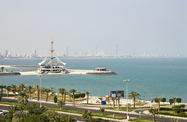Non-oil growth and higher domestic consumption combined to drive up economic activity in Kuwait in 2014, although plunging world oil prices and relatively flat domestic production look set to weigh on the state’s finances.
Bolstered by rising capital expenditure and a host of infrastructure projects set for roll-out between 2015 and 2019 during the mid-term phase of the Kuwait Development Plan (KDP), 2015 should see continued growth in non-oil sectors.
Kuwait posted a $45bn surplus during the 2013/14 fiscal year – its second-largest on record – with oil revenues climbing to KD29.3bn ($99.6bn), according to the latest data issued by the Ministry of Finance. The IMF forecasts that the current account and fiscal surpluses should remain high into 2015, following years of record budget surpluses. However, these are likely to slip due to recent developments in the global oil market.
According to an IMF report published in December, non-oil expansion will reach 3.5% in 2014, driven by increasing domestic consumption and steady growth in public capital spending and private investment. The fund said it expected non-oil activity to support real GDP growth of 1.3% in 2014, with inflation likely to remain steady at about 3%.
Oil prices take their toll
However, lowering oil prices are taking their toll on the economy. Government revenues declined by 8.1% year-on-year (y-o-y) to reach KD17.2bn ($58.6bn) in the seven months to October, according to official data in December.
A drop in global oil prices is likely to continue to eat into revenues in 2015, with analysts and global watchdogs forecasting further falls this year. The International Energy Agency said in its monthly report mid-January that a price recovery is not imminent, but signs were mounting that the situation will change, most likely in the second half of the year.
The National Bank of Kuwait (NBK) said that the fiscal surplus is likely to shrink from 26% of GDP in 2013/2014 fiscal to 17% during the 2014/15 fiscal year, sliding further to 11% in 2015/16, as a result of falling oil prices with a slight projected decline in oil production in 2015.
The government has moved to reduce the estimated $17bn in subsidies it pays annually. The finance minister, Anas Al Saleh, announced plans to cut diesel subsidies in June 2014, while also confirming the government’s plans to reduce assistance with kerosene and electricity.
All eyes on infrastructure
Economic diversification will play a critical role in future growth, as a national drive to transform the state into a financial and trade centre by 2035 under the KDP gains pace.
Divided into five half-decade plans, the KDP’s first iteration ran from 2010-14. The second, scheduled for launch in April 2015, is focused on the construction of a raft of megaprojects and heavier private sector involvement. Initiatives include a $20bn metro and rail project, expected to break ground in 2017, the $1.2bn Mubarak Port project and Media City. The long-term plan also allows for increased private sector participation in economic development.
Capital expenditure is rising, with NBK reporting that spending increased 33% y-o-y to KD600m ($2.05bn) in the seven months to October. Transportation and equipment spending increased by 57% y-o-y, while spending on maintenance and land purchases also rose by 32% y-o-y.
Construction on a roll
Construction contracts soared in 2014. Data issued by NBK showed that more than $20.7bn worth of contracts had been awarded by the end of August, almost double the full-year total for 2013. Big-ticket awards in 2014 included $12bn in contracts for the clean fuels refinery upgrade project. In a separate move, a consortium comprising Kharafi National and Turkey’s Limak Holding was awarded a $4.8bn contract in November 2014 for the construction of a terminal, runway and 30 gates at Kuwait International Airport.
The government is planning to spend KD45.5bn ($155 bn) on projects over the next five years despite the plunge in world oil prices, according to parliament’s financial and economic affairs committee secretary, Mohammad Al Jabri speaking in January. Oil revenues in the new budget from April will be calculated on the basis of $45 a barrel, down from $75 a barrel in the current fiscal year, Jabri added.
Despite the weakening global conditions, Kuwait’s fiscal position remains solid. Its sovereign wealth fund and other government investments are valued at $500bn, or 310% of GDP, while the IMF describes Kuwait’s medium-term economic outlook as favourable on the back of an anticipated surge in new infrastructure investment and domestic consumption.

